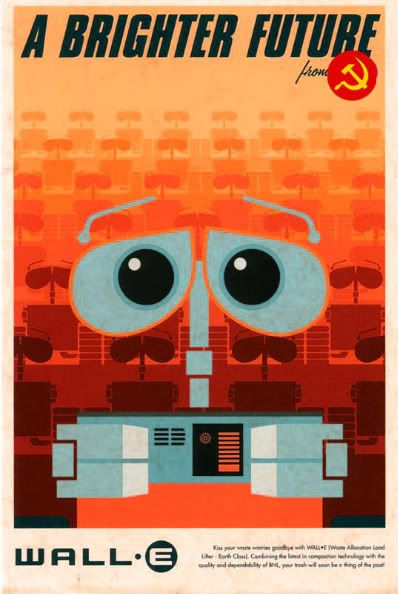- The Communist Manifesto

Yes, yes, I’m a photoshop wizard.
I’m not a Marxist, despite being involved in academia. Although I am familiar with dialectical materialism, and sympathize with the workers of the world, I have my own philosophical objections to Marxism, or rather, a lack of belief in its ability to genuinely work given the capacity of human nature to seek a better life for oneself, sometimes at the expense of others. But that is irrelevant.
Before I get too into this, this is ever so slightly tongue-in-cheek. Like I mentioned in a roundabout way my blog on narrativization, I’m of the opinion that anyone can provide any number of readings on a text, if they have the desire and the rhetorical skills. For somebody to make a serious Marxist reading of Wall-E (Andrew Stanton, 2008) is inevitable, I think the reading is kind of obvious (the machine-human metaphor, a classed robot system, the commercialism criticism, so on.) Which makes this only all-too easy.
I don’t want to exactly compose a review for Wall-E, since (as the Forgotten Filmography Fridays prove) I am of the Jay Sherman School of Film Criticism: “If you don’t have anything critical to say, don’t say anything at all.” I found it incredibly sweet and polished, like every other Pixar film I could name, and if you like any Pixar movies, you should like this one. Except Cars. I don’t care much for Cars, primarily because all the NASCAR jokes. And Larry the Cable Guy.

The one guy worse than Jeff Foxworthy.
Anyway, bad tangent. From here on in I’ll be talking about Wall-E in specific. I don’t think anyone who isn’t a diehard Pixar fan will be complaining about spoilers, and those who are will have already seen it likely. But I talk about specific plot elements (including the ending,) so I’m giving you fair warning.
One of the primary themes in Wall-E is about functionality, or as Wall-E and EVE refer to them, “directives.” Each machine has its directive, and a determined function that is based on their nature: Wall-E is supposed to crush garbage, Mo the scrubber robot is supposed to scrub, the makeup robot is supposed to apply makeup, and so on. The robots then are the Marxist proletariat, struggling to survive and put upon by the larger socioeconomic system.
The people in Wall-E are the bourgeoisie, they control the means of production, and they reap all the rewards of robot labor. They are complacent and overindulged, confined to their hoverchairs and drinking all their meals out of cups. This produces a culture that is obsessively consumeristic, running along the same paths, doing the same events, and getting the latest colored jumpsuit (Blue is the new Red) from Buy’N’Large.
It is the intention of the Autopilot to keep this system, for both sides of the equation, running indefinitely. When confronted with the possibility of an alternative, Auto is unable to see the potential of a life outside of the robot-human class system, even if there is the possibility of returning to Earth, it will not break from its previous orders to remain in a holding pattern. It sees nothing but the functionality and function of the system. Perhaps it is the “invisible hand of the market” (Adam Smith terms, not Marx’s, I know,) who keeps the system working even in the face of evidence like the viability of Marxist socialism (or perhaps despite of it.) Or the elite who wishes to keep its position in the system secured, since what use is a spaceship autopilot on Earth?
This, of course, leads to a total revolt, human (the Captain and a few “enlightened” humans) and machine (Wall-E and EVE, along with their ragtag bunch of misfit malfunctioning robots who try to exist outside of their preset functions) rise up together to change the system and work together to create a better tomorrow for both their kinds. They had nothing to lose but their chains.
This kind of functionality, in a machine metaphor no less, is also expressed in another film that was created by what would become the Pixar team, the perennial classic, The Brave Little Toaster (Jerry Rees, 1987,) where the old appliances find themselves facing the fate of every object that’s outlives its usefulness.
Also, I want to do this to most of the cars in Cars.
But, the Brave Little Toaster is clearly an allegory for the life, death, and resurrection of our Lord Jesus Christ (to be saved for a future blog. Stay tuned.)
Is Wall-E intended to be Marxist? Unlikely. Critical of current consumer culture? (I love alliteration.) Most definitely, but I doubt they’re actually advocating all-out class warfare. Speaking of critical consumerism, make sure to buy all your Wall-E merchandise, if not now, then at your next visit to Disneyland. Your Wall-E t-shirt, your Wall-E cap, your Wall-E action figure, your Wall-E Poster, video game, flatware set, bedsheet set, and your Buy-N-Large T-shirt, &tc. But make sure it’s the real deal, and not some cheap imitator.
*(By the way, all of the items I thought I just made up are available at the Disney Store. In case you were wondering.)
Robots of the world unite!
No comments:
Post a Comment